|
1. Rinse and DRY Packaging metal parts before they are dry Stacking or packing metal parts into boxes after being taken directly out of a cleaning solution without thoroughly drying them will result in rust. When washing or cleaning parts, do not stack or package them until completely dry. Wet parts rust when stacked on top of each other because the fluid acts as an electrolyte and forms a galvanic cell between the two parts. SOLUTION: Make sure metal parts are thoroughly dried before stacking them or packing them into boxes. Placing metal parts in a wire basket allows them to air dry quickly. Vibratory action, forced air, and heat can also dry parts more quickly. Soon after the metal parts are dry, package them in TechCorro™[P] VCI paper or TechCorro™[F] VCI film to prevent corrosion from occurring.  2. Keep it Clean! Dirty cleaning solution causes corrosion Small metal particles, also called swarf, in the metalworking or cleaning solution can end up on metal parts. If not properly washed away, these particles can form a galvanic corrosion cell and corrosion will occur underneath the swarf. SOLUTION: Keep your metalworking fluids and cleaning solutions clean and free of dirt and swarf. Fluids and solutions should be checked on a regular basis and kept free of contaminants that can cause corrosion. 3. Dirty Water Using public/city water for cleaning fluids or water-based rust inhibitors Public/city water can contain high chlorine levels and other chemicals that can cause corrosion. The pH of public/city water can also vary greatly. As we will see in the next most common reason for corrosion, proper pH also plays an important role in preventing rust and corrosion on metal parts. SOLUTION: Switch from public/city water to distilled or deionized water. Additionally, use Dry Coat™ Rust Preventative Spray which is a ready-to-use, water-based rust inhibitor. 4. Adjust the pH! Improper pH level of cleaning solutions Proper pH levels depend on the type of the metal parts. For ferrous parts, a pH level of at least 9.0 should be maintained. For nonferrous metal parts such as copper and alloys like brass and bronze, a pH level of 7.0 - 7.5 should be maintained. SOLUTION: Regularly check and correct pH levels of all cleaning solutions. Adjust pH levels according to usage guidelines.  5. Never Play With Fire! Storage of metal parts near manufacturing areas Metal parts stored close to manufacturing areas, specifically heat-treating and grinding processes, can become contaminated which leads to corrosion. SOLUTION: Cover all metal parts with TechCorro™[P] VCI paper or TechCorro™[F] VCI film to protect them. 6. Keep Your Cool! Failure to maintain the proper temperature in manufacturing and shipping areas For every 10 degree Celsius increase in temperature, corrosion rates can double. Fluctuations in temperatures cause metal pores to open and can also cause condensation to form on parts. Condensation becomes an electrolyte, allowing corrosion to occur. High humidity can cause electrolytes to form on the surface of metal parts enabling the corrosion cell to form and allowing corrosion to propagate. When packaging parts in high humidity that kind of atmosphere is being locked into the package. SOLUTION: Maintain lower temperatures and lower humidity levels by installing climate controls, air conditioning, and/or dehumidifiers. 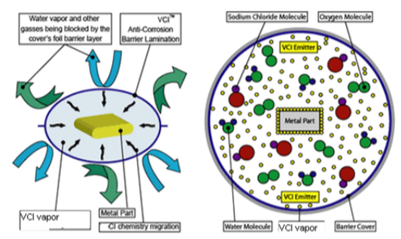 7. Cover Up! Leaving metal parts uncovered and unprotected Leaving parts uncovered while sitting in the plant, waiting for secondary operations, in queue for additional machining, drilling and tapping, waiting to be packaged, etc. makes parts susceptible to rust and corrosion. Parts left uncovered in the plant are susceptive to forklift exhaust. Chlorides, sulfides, and oxides from the exhaust contribute to the corrosion of metal parts. SOLUTION: Cover all metal parts with TechCorro™[P] VCI paper or TechCorro™[F] VCI film, protecting them from oxygen and contaminants that are in the plant atmosphere.  8. Caught Red-Handed! Employees handling metal parts with bare hands Fingerprints and perspiration are one of the biggest contributors to corrosion. Acids, oils, and contaminants on human hands can cause and accelerate corrosion. SOLUTION: All employees who handle metal parts including production workers, inspectors, and packaging personnel should always wear gloves when handling parts.  9. Not So Eco-Friendly Direct contact of metal parts with corrugated cardboard, wood, or paper All forestry products (wood, paper, or corrugated board) contain moisture, acids, and chlorides that cause corrosion. Direct contact with these materials causes “contact corrosion” meaning parts will rust in the areas of direct contact that is made with these products. This often causes sporadic rust having some parts in a particular shipment with rust and others without. Under certain conditions some glues used in corrugated cardboard may give off corrosive gasses. SOLUTION: Line boxes, crates, etc. with TechCorro™[P] VCI paper or TechCorro™[F] VCI film. This creates an effective barrier between metal parts and the wood sourced products that cause rust. 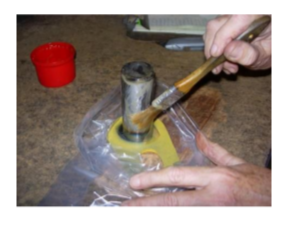 10. Oil Doesn’t Mix Use of rust preventative oils instead of VCI packaging R.P. Oils are the traditional method of preventing rust and corrosion. However, R.P. Oils are messy, labour intensive, and bad for the environment. R.P. Oils are less effective than VCI products when it comes to preventing rust. SOLUTION: The obvious solution to this mistake is to switch from R.P. Oils to TechCorro™[P] VCI paper, TechCorro™[F] VCI film, or Dry Coat which is a waterbased, rust inhibitor liquid. We have successfully helped hundreds of companies switch to TechCorro™ products from R.P. Oils producing great results! 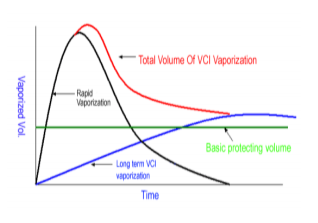 11. Know the Product Improper use of VCI products due to lack of knowledge Another common reason for corrosion on metal is using poor quality VCI products. Too high a vapour pressure will cause the inhibitor to be released to such an extent that a protective concentration cannot be maintained. On the other hand, a low vapour pressure inhibitor is not used up as quickly and can assure more durable protection, but more time is needed for a protective vapour concentration. Proper selection of volatile compounds enables controlled and dependable volatilisation. SOLUTION: Always follow TechCorro™ usage guidelines when using TechCorro™ products. Consult with an expert to design a VCI system for your specific application and help you implement the usage of TechCorro™ products properly. Technology Packaging team members are always happy to help.  12. Can’t Get Enough VCI! Not using enough VCI product The internal space needs to be saturated with VCI vapour before the VCI can condensate on the metal surface. If the amount of VCI is not sufficient, a protective concentration may never be reached. More than 1000 types of VCI compounds are known, but only a fraction of them are efficient, cost effective, and environmentally friendly. SOLUTION: As a general rule, use 1 m² (10 ft²) of TechCorro™[F] VCI film for every 1 - 2.5 m² (10 - 25 ft²) of metal surface. Use at least 4-6 m² of TechCorro™[P] VCI paper for every 1m3 of void space.  13. Do the Homework Lack of knowledge and training Technology Packaging cannot control variable conditions such as temperature, humidity, airflow, end-user production methods, surface area of metal to be protected, customer employee training, and other factors that are beyond our control. It is impossible to guarantee any shelf life in this regard. However, Technology Packaging does guarantee the amount of VCI that is impregnated into the packaging for two years. SOLUTION: Make sure to follow TechCorro™ usage guidelines and train all employees accordingly. Technology Packaging provide bespoke packaging and corrosion preventive training to its customers. 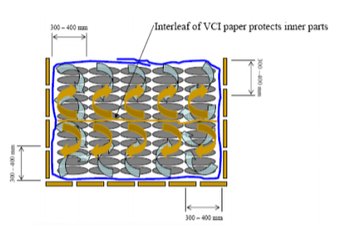 14. Protection Radius Improper placement of VCI products The corrosion protection radius depends on the vapour pressure of the VCI used in the master-batch formulation. Ingredients with higher vapour pressure can reach farther areas and are usually called Vapour Phase Protectors. Ingredients with lower vapour pressure only reach areas in close proximity and are usually called Contact Phase Protectors. SOLUTION: VCI vapours from TechCorro™[P] VCI paper can diffuse into the air up to 30cms. Under normal circumstances don’t place metal parts beyond 30cms away from the closest VCI source unles you check with Technology Packaging’s team.  15. Condensation! Moisture: the main corrosion promoter. Moisture accelerates corrosion. Moisture can cause normal temperature variations to be accentuated inside of a package making air move upwards, like in a chimney. As air either heats or cools, it flows up and down inside the package causing temperature variations and repeated evaporation and condensation. Condensation and evaporation cycles will repeatedly bring contaminates in contact with the metal surface as well as provide thermal conductivity promoting temperature gradients and electrical potential differences on the metal surface.  SOLUTION: Stuff TechCorro™[P] VCI paper into the packaging to prevent the chimney effect and block any air flow. Another solution is the use of TechCorro™ Desiccant to absorb moisture inside of the package.
0 Comments
Your comment will be posted after it is approved.
Leave a Reply. |
Archives
March 2021
Categories
All
|
Copyright 2018 by Technology Packaging Ltd Privacy Statement & Cookies | Terms Of Use


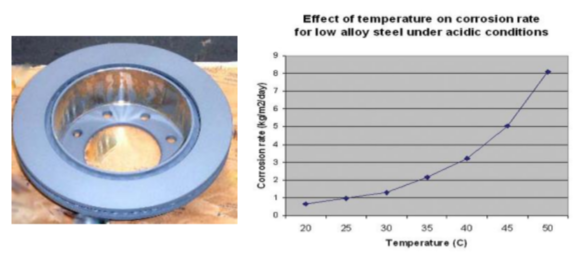
 RSS Feed
RSS Feed